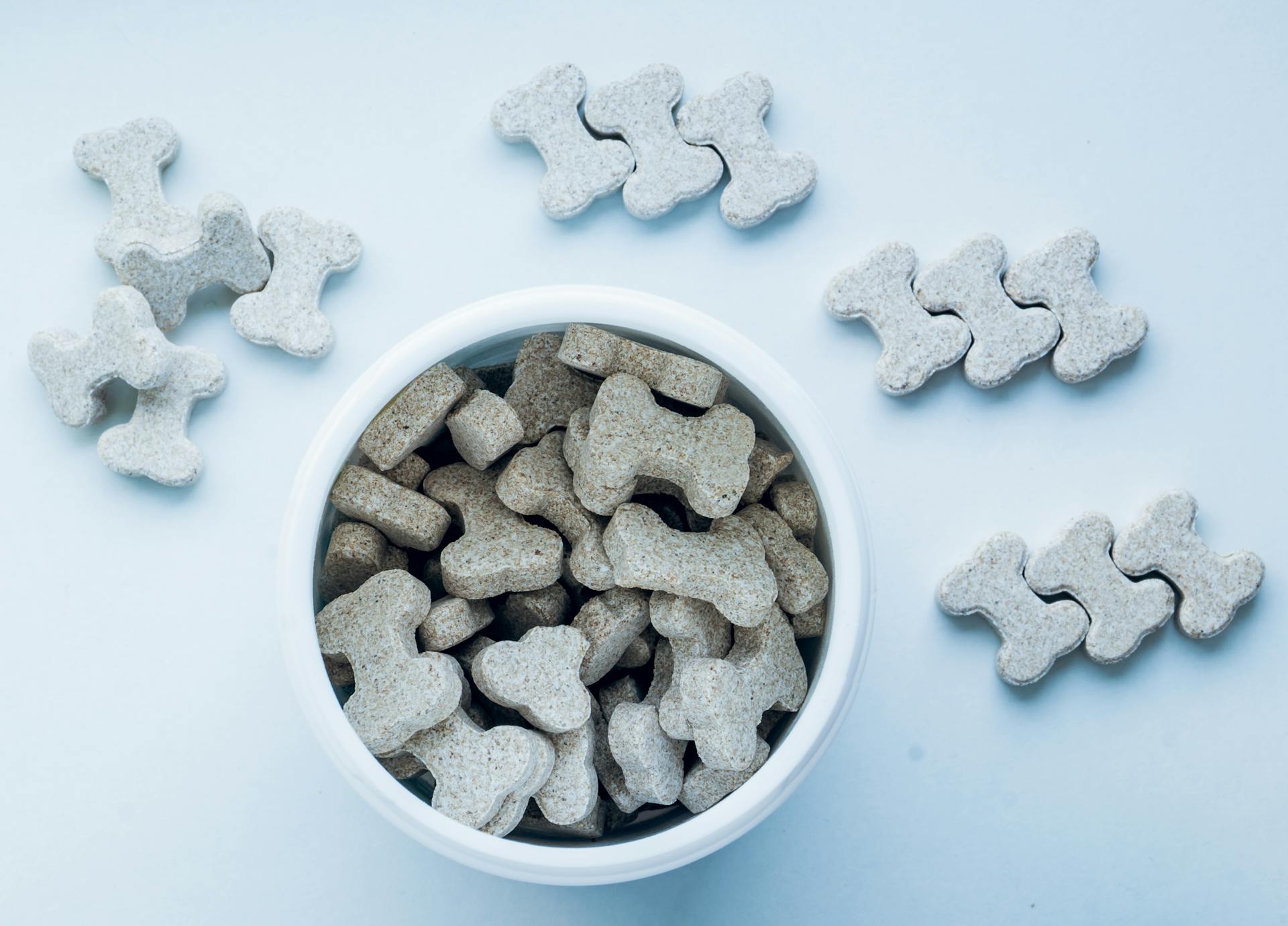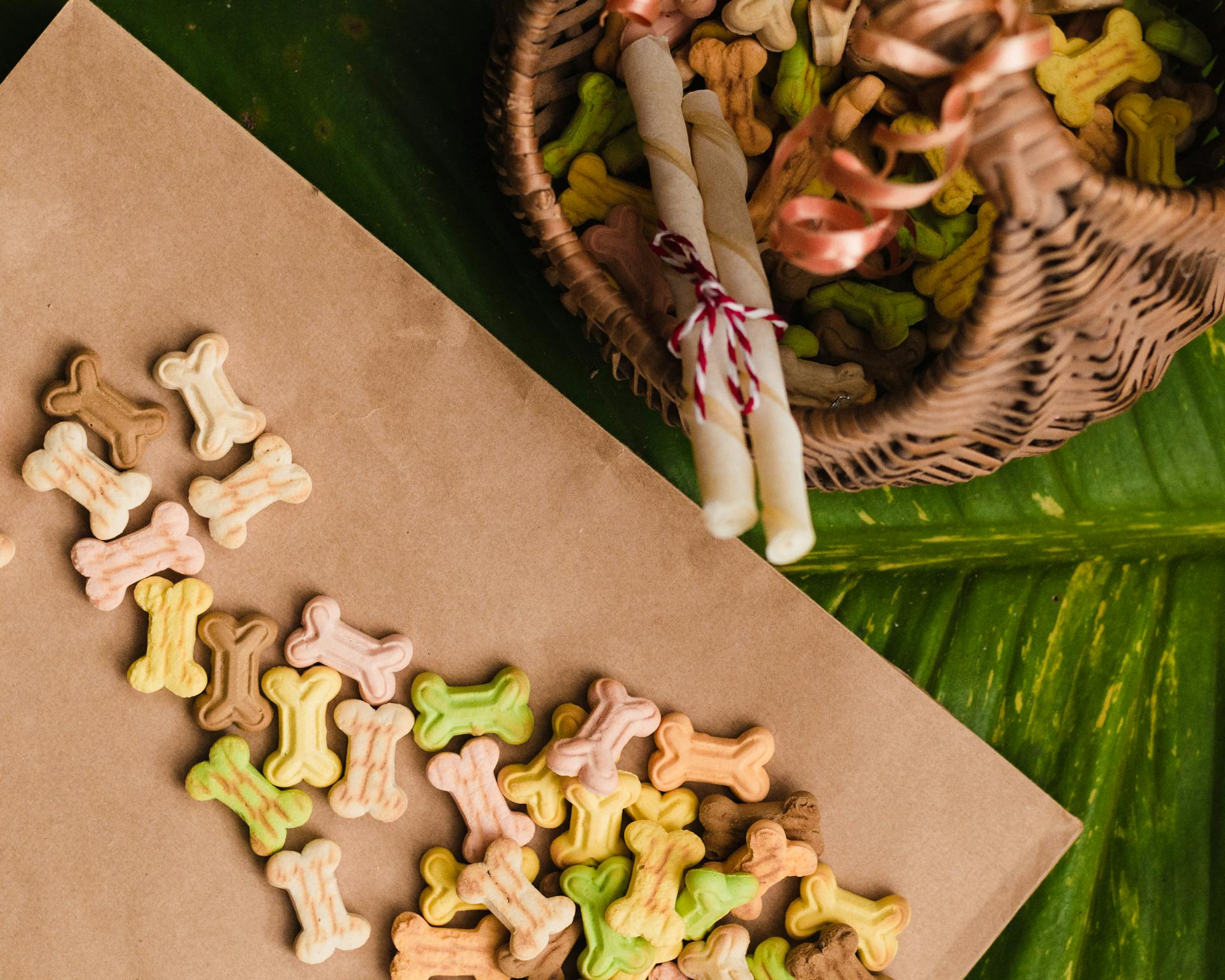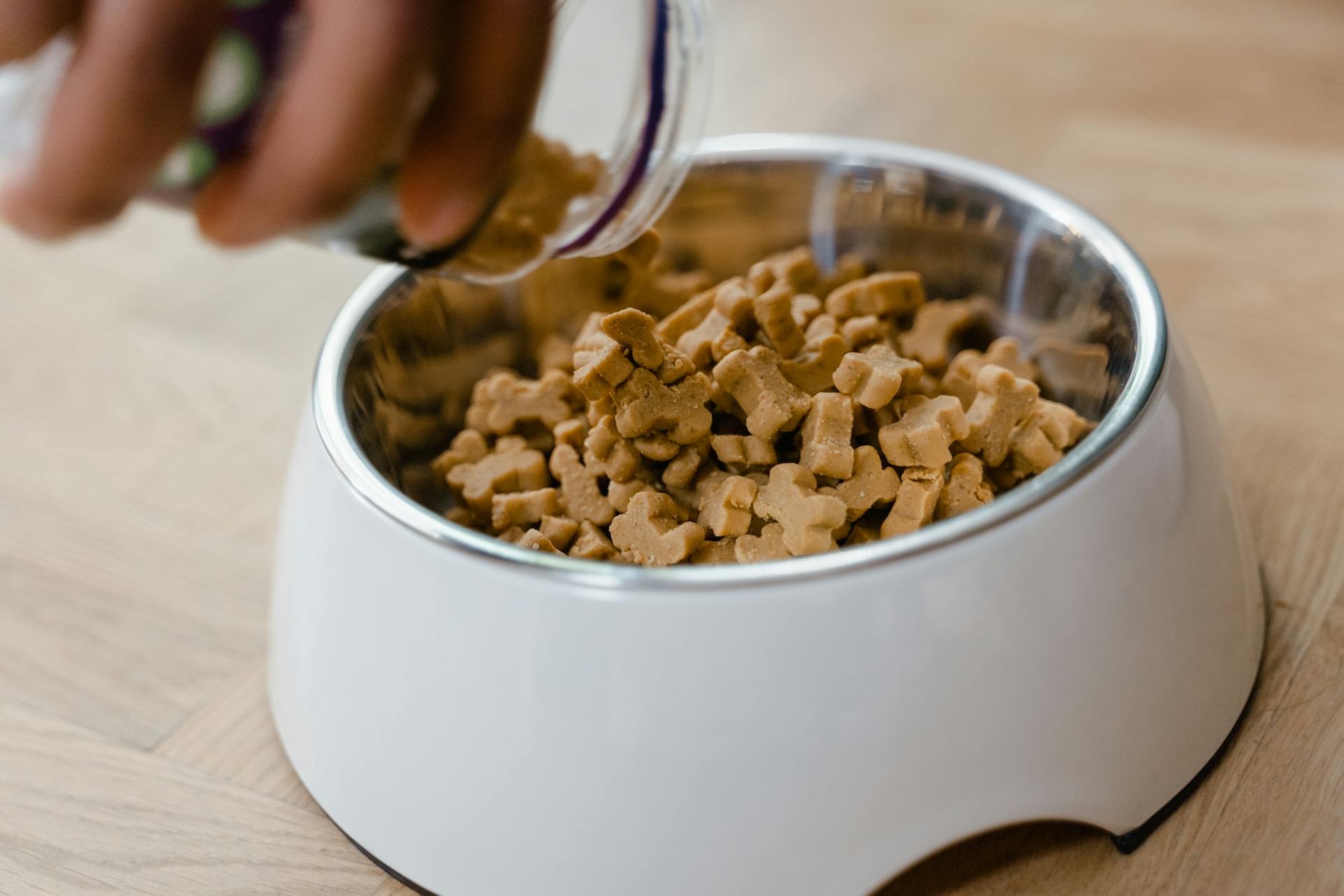
Dog biscuits can last anywhere from a few days to several months, depending on the ingredients and storage conditions.
If stored properly in an airtight container, dog biscuits can last up to 2 weeks at room temperature.
However, if you notice any signs of spoilage, such as an off smell or mold, it's best to err on the side of caution and discard the biscuits immediately.
Proper storage is key to extending the shelf life of dog biscuits.
Understanding Expiration Dates
Expiration dates on dog food and treats are more than just guidelines - they're a warning sign that the product's nutritional value is starting to degrade.
Consider "best by" dates as expiration dates, as they mark the point at which the product's potency and nutritional value start to decline.
Nutritionists calculate the degradation of ingredients, vitamins, and minerals when formulating dog food, so by the time you reach the "use by" date, the product is likely running on empty nutritionally.
A study from the National Institutes of Health found that people often overlook temperature warnings when storing dog food, which can lead to rancidity and degradation.
Room temperature is the most overlooked parameter during storage, and exposure to warmth can enhance rancidity, especially in diet formulations rich in fats and oils.
Dog treats expire too, and their packaging often includes a "best by" date or a warning to use within 30 days after opening.
Once you open a package of treats, air hits the product, causing it to degrade, so it's essential to pay attention to these warnings and use the product within the recommended timeframe.
The "best by" date is no longer relevant once you open the package, so use the four to six weeks rule of thumb to decide when to toss any remaining treats.
Recommended read: Best Healthy Dog Biscuits
Factors Affecting Shelf-Life
Preservatives are often used in dog treats to extend their shelf life. These substances slow down the process of decay and prevent the growth of bacteria and fungi.
Some preservatives are natural, like tocopherols (a form of Vitamin E), while others are synthetic chemicals such as BHA and BHT.
Synthetic preservatives like BHA and BHT can keep treats fresh for longer periods, but they've been linked to health issues including allergies and cancer.
Natural preservatives like tocopherols are a safer alternative to synthetic chemicals.
Storage and Preservation
Storage and preservation are crucial when it comes to extending the shelf life of dog biscuits. You can increase the edible life of homemade dog biscuits by using quality ingredients, hygienic food handling, moisture control, and proper storage conditions.
For most homemade dog biscuits, using quality ingredients and proper storage conditions are the primary lines of defence against spoilage. It's essential to store dog biscuits in airtight containers to prevent moisture and air from entering the container.
Storage containers should be thoroughly cleaned and sanitized to prevent bacterial growth. Airtight containers, such as glass jars or plastic containers, are ideal for storing dog biscuits. If you're storing dog biscuits in the fridge, make sure the container is airtight to prevent moisture from entering.
Dry biscuits, like biscuit-type snacks or chewy sticks, can last for years if stored properly. They're designed to have a long life and maintain their freshness over time.
Readers also liked: Long Lasting Dog Treats Homemade
Storage Containers

Storage containers are a crucial part of preserving dog treats. For most dog treats, airtight is best and less air is better, so aim for a full container (or sealed bag) if possible.
When storing dog treats in the fridge, it's essential to use an airtight container to prevent moisture from entering and affecting the treats. This is especially important for dry treats, which can become soggy if exposed to moisture.
I use small glass jars for short-term supplies at room temperature and for refrigerated treats. Glass jars are a great option because they're easy to clean and sanitize, and they can be reused multiple times.
Well-used plastic containers can be difficult to completely sanitize due to surface scratches, which is an issue worth noting for human food safety too. If you do use plastic containers, make sure to thoroughly clean and sanitize them before storing dog treats.
If you're storing dog treats in the freezer, it's best to use a container that's specifically designed for freezer storage. These containers are usually made of durable materials and are designed to prevent freezer burn.
Check this out: How Long Do Dog Calming Treats Take to Work

Here are some general guidelines for choosing the right storage container for your dog treats:
- Use airtight containers to prevent moisture from entering
- Choose containers that are easy to clean and sanitize
- Use glass jars for short-term supplies at room temperature and for refrigerated treats
- Use plastic containers with caution, as they can be difficult to sanitize
- Use containers specifically designed for freezer storage when storing dog treats in the freezer
Jerky
Jerky can be a convenient snack for your furry friend, but it does have a shelf life. Jerky treats can last up to four months if stored unopened and up to two months if stored after opening.
To keep jerky fresh, store it in resealable bags or air-tight containers. This will help prevent bugs from getting into the treats.
If you don't plan to use the jerky within two months, consider storing it in the freezer. Unopened jerky can be frozen for up to six months.
To preserve the freshness of your pup's jerky, you can even vacuum seal it. This will help keep the treats fresh for a longer period.
For more insights, see: How Long to Keep Dogs off New Sod?
Freeze-Dried Yummies
Freeze-dried treats can last up to 18 months unopened in rooms with little to no humidity.
These types of treats can be stored for a long time, but it's essential to keep them in proper conditions.
Freeze-dried treats can last up to a year opened on the shelf, as long as they're stored properly.
By keeping them in a dry environment, you can enjoy your dog's favorite snacks for a longer period.
Physical Signs of Spoilage
If you notice any of these changes, it's best to err on the side of caution and toss the treats. Some physical changes indicating spoilage include a change in color, which can be a sign that the dog treats have gone bad.
A foul smell is another indication that your dog's treats have spoiled. This is often accompanied by mold or mildew growth, which can appear as a greenish or blackish patch on the surface of the treats.
Hardened or dried out texture is also a sign that the dog treats have spoiled. Treats that are no longer soft and chewy are likely past their expiration date.
Here are some physical signs of spoilage to watch out for:
- Change in color
- Foul smell
- Mold or mildew growth
- Hardened or dried out texture
Preservatives
We don't use any special preservatives when making our dog treats, but some ingredients have natural preservative properties.
Some treat ingredients have natural preservative properties, but these generally aren’t used in sufficient quantities to make a substantial difference to shelf life.
Using quality ingredients is crucial to extending the life of homemade dog treats.
For most homemade dog treats, hygienic food handling is a must to prevent spoilage.
Moisture control and proper storage conditions are also essential for keeping homemade dog treats fresh.
Natural preservative properties may be altered by the cooking/baking process, so it's essential to be mindful of this when making homemade dog treats.
Shelf-Life Expectations
Dehydrated dog treats have a longer shelf life compared to homemade options, typically up to 2 years, due to their low moisture content.
Commercially prepared dehydrated treats are made to be dry, which prevents bacterial growth and helps them last longer.
Homemade dog treats, on the other hand, are usually fresher with higher moisture content, making them more prone to spoilage.
If not stored properly, homemade dog treats can spoil within a week.
It's essential to store homemade dog treats in airtight containers to maintain their freshness.
Here's a quick summary of shelf-life expectations for different types of dog treats:
Keep in mind that even if your dog treats have passed their expiration date, they're unlikely to harm your pet, but they may not be as tasty or nutritious.
Health Risks
Expired dog biscuits can be a serious health risk for your furry friend. Bacteria and mold may grow on them once they're past their best before date, leading to potential food poisoning.
Consuming spoiled dog biscuits can lead to painful conditions like pancreatitis, gastroenteritis, and foodborne illnesses. These conditions can be life-threatening if not treated promptly.
Some common symptoms of food poisoning in dogs include vomiting, diarrhea, and abdominal pain. If you suspect your dog has eaten spoiled biscuits, it's essential to seek veterinary attention right away.
Here are some potential health risks associated with expired dog biscuits:
- Pancreatitis
- Gastroenteritis
- Foodborne illnesses
Frequently Asked Questions
How long does it take for dry dog food to go bad?
Dry dog food typically lasts 18 months unopened and 6 weeks after opening, when stored properly. Proper storage is key to maintaining its freshness.
Sources
- https://www.dalmatiandiy.com/shelf-life-and-storage-for-baked-dog-treats/
- http://www.dogtreatkitchen.com/shelf-life-of-dog-treats-46-months-please-help.html
- https://www.whole-dog-journal.com/food/does-dog-food-expire/
- https://lepepitefrenchies.com/can-dog-treats-go-bad/
- https://post.bark.co/food/can-dog-treats-expire/
Featured Images: pexels.com

